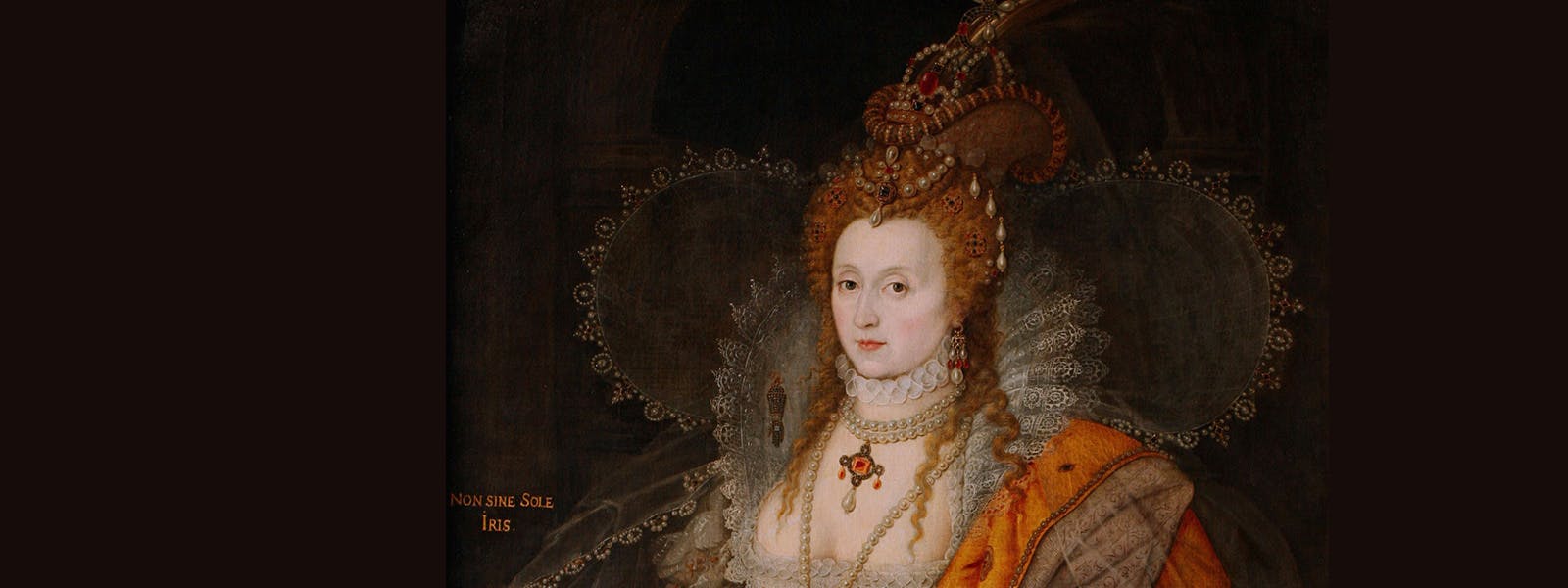
From Tower prisoner to English Queen
Queen Elizabeth I was the last monarch of the Tudor dynasty. Her reign, known as the Elizabethan era, lasted from 1558 until her death in 1603. The daughter of Henry VIII and Anne Boleyn, Elizabeth became Queen aged 25, at a time of political crisis. Known as the 'Virgin Queen', she never married but instead pledged her body to England itself.
Elizabeth’s path to the throne was by no means smooth. After her mother was executed at the Tower of London, the young Princess was declared illegitimate. The reigns of her brother, Edward VI and her older sister Mary I, saw England beset by religious conflict and impoverished by war.
Elizabeth was imprisoned in the Tower of London, and held under house arrest at Hampton Court Palace, on suspicion of plotting against Mary. This was a Tudor dynasty at war with itself. What would happen next?
Header image: Queen Elizabeth I, 'The Rainbow Portrait' (detail), by Isaac Oliver, c1600. Reproduced by permission of the Marquess of Salisbury, Hatfield House
Did you know?
At Hampton Court Palace, Elizabeth created a 'Paradise Room', decorated with precious metals and gems to dazzle visitors.

Image: Elizabeth I in her coronation robes, a copy of about 1600 of a lost original painting. © National Portrait Gallery, London
When people think of Elizabeth, they think of the Virgin Queen, Gloriana, not the quite vulnerable young woman that she was, who didn't know she was going to be queen. She was born as an heir to the throne, but of course didn't stay an heir for long.
Tracy Borman, Chief Historian at Historic Royal Palaces
Read more: The Elizabethan era: a golden age?

Image: Henry VIII, by Hans Holbein the Younger, c1537, © Museo Nacional Thyssen-Bornemisza, Madrid.
The birth of Elizabeth I
The future Elizabeth I was born at Greenwich Palace on 7 September 1533. Her arrival was a disappointment for Henry VIII. During the Tudor period, it was felt that women should not rule in their own right, so the King craved a son and heir to ensure the future of his dynasty.
The celebrations at court were muted, ‘very cold and disagreeable … and there has been no thought of having the bonfires and rejoicings usual in such cases’, according to the Imperial Ambassador Eustace Chapuys. The official letters sent out to announce Elizabeth's birth were corrected at the last minute, to change the word ‘Prince’ to ‘Princess’.
Henry’s enemies believed that the birth of a daughter was divine punishment for the King’s controversial divorce from his first wife, Katherine of Aragon.
Read more: Henry VIII’s wives: six queens, six women
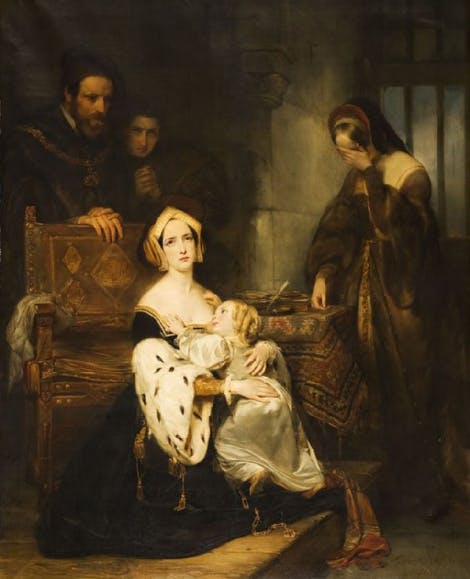
Image: Anne Boleyn saying a final farewell to her daughter Elizabeth, in an imagined scene painted much later by Gustaaf Wappers, 1838, © Shunck Collection, GH63.08
Execution of Anne Boleyn
Elizabeth was still only two years old when her mother was executed for treason.
Anne Boleyn’s fate meant that the little girl was no longer a princess, declared illegitimate and kept out of the way, living with a small entourage at the royal manor of Hatfield House in Hertfordshire.
The ‘Lady Elizabeth’ returned to court in 1537, to celebrate the birth of her half-brother Edward – a son, finally, for Henry VIII, with his new wife Jane Seymour.
At Edward’s extravagant christening at Hampton Court Palace, Elizabeth took her place in the procession to the Chapel, carrying her brother’s chrisom, the ceremonial baptism cloth.
Read more: Anne Boleyn
Lady Elizabeth's education
Back at Hatfield, and despite her illegitimacy, the King appointed tutors to manage his daughter’s education. Elizabeth excelled, learning at least five languages (French, Italian, Spanish, Latin and Flemish) under the expert guidance of humanist scholars like Roger Ascham and John Cheke.
Did you know?
Later in life, Elizabeth learned Scottish, Irish and even Cornish.
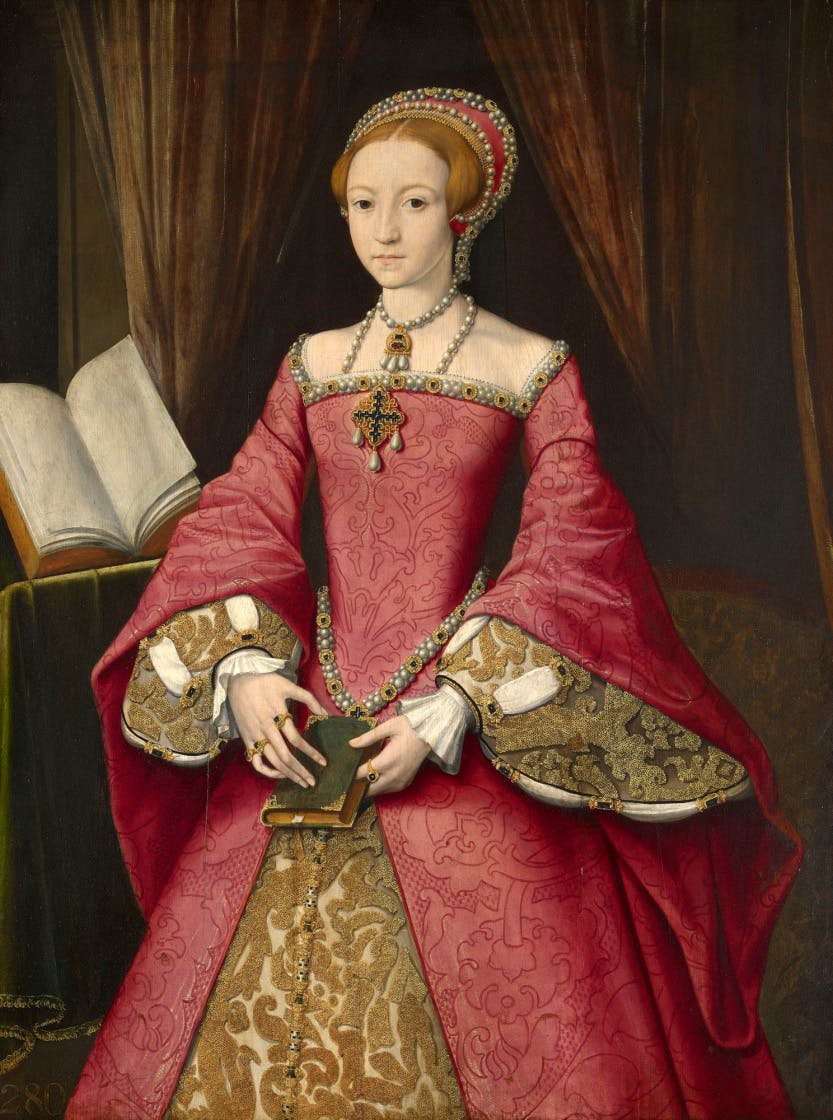
Image: Portrait of Elizabeth, aged 13, attributed to William Scrots, c1546. The future queen is depicted as a paragon of Renaissance elegance, learning and virtue. Royal Collection Trust / © Her Majesty Queen Elizabeth II 2019, RCT 404444
Her mind is no womanly weakness and her perseverance is equal to that of a man... She delights as much in music as she is skilful in it.
Princess Elizabeth's tutor, Roger Ascham in 1548
Elizabeth's return to court
After Henry VIII’s final marriage to Katherine Parr in 1543, the King, conscious of his failing health and encouraged by Katherine, sought a more permanent reconciliation with his daughters Elizabeth and Mary.
Both were included once again in the line of succession.
The young woman with her father’s red hair and (for those who dared to remember) her mother’s dark eyes was a remarkable presence at court.

This important dynastic portrait of Henry VIII and his family shows the King flanked by his third wife, Jane Seymour and Prince Edward, later Edward VI. On the left is Princess Mary, later Mary I, the King’s daughter by his first wife, Katherine of Aragon, and on the right Princess Elizabeth, later Elizabeth I, his daughter by his second wife, Anne Boleyn.
Image: ‘The Family of Henry VIII’ (detail), by an unknown artist, c1545. This painting was possibly commissioned by the King towards the end of his reign. Royal Collection Trust / © Her Majesty Queen Elizabeth II 2019, RCIN 405796

Henry VIII's lost gardens at Hampton Court
Explore Henry VIII's cherished garden retreat, through a collection of 16th-century treasures
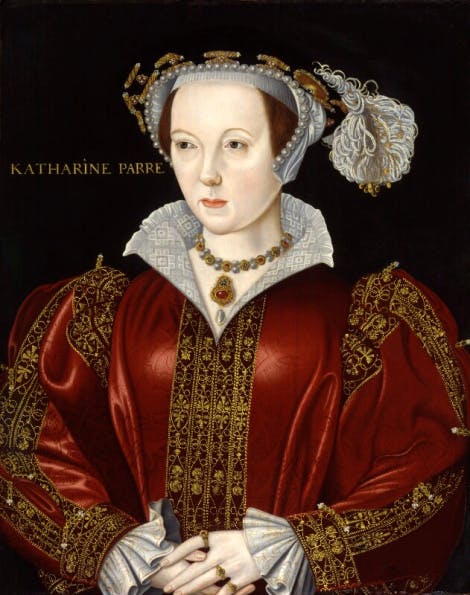
Image: Katherine Parr, by an unknown artist in the late 16th century, probably copied from a lost original portrait. © National Portrait Gallery, London
Elizabeth and Katherine Parr
Katherine Parr seems to have exerted a strong and positive influence over Elizabeth at this critical period of her life. The Queen encouraged Elizabeth's learning and taught her about Protestant reform. She also read classical texts, including Cicero, and discovered the power of oratory. Elizabeth even translated Katherine's essay, ‘Prayers and Meditations’ – into Latin, Italian and French – and presented it to her father.
In 1544, Elizabeth spent a happy summer at Hampton Court, watching her stepmother act as Regent. Elizabeth arrived at court to find Katherine exercising full powers in her husband’s absence; for the first time in Elizabeth's life, a Queen presided over the court. This summer would profoundly influence the young princess, the same year she was restored to the succession.
Even after Henry VIII’s death in 1547, this happy and fertile period of Elizabeth’s life continued. She was welcomed into Katherine’s home at Sudeley Castle, with her new husband Thomas Seymour; Seymour was uncle to the new King, Elizabeth's brother, Edward VI.
The Seymour scandal
Thomas Seymour, Lord High Admiral, proved a poor choice of guardian for Elizabeth. Within days of joining Katherine at Sudeley Castle, Elizabeth began to receive early-morning visits from the 38-year-old Seymour, who would appear in her room dressed in his nightclothes. Elizabeth was protected by her governess, Kat Ashley, who warned him off.
Thomas Seymour’s harassment of the 14-year-old Elizabeth became insidiously more dangerous. Katherine reportedly found Seymour alone in a room with Elizabeth, his arms around the Princess.
The death of Katherine Parr
In the spring of 1548, Elizabeth was sent away. But later that year, Katherine Parr died in childbirth, and Seymour renewed his attentions.
Seymour perhaps saw Elizabeth as a means of acquiring power. But in January 1549 he was arrested for conspiring to kidnap Elizabeth's brother, King Edward VI and his lecherous behaviour with Elizabeth was unmasked. Seymour was beheaded for treason two months after his arrest.

Image: Elizabeth had grown close to the new King, her brother Edward, but the Seymour affair strained their relationship. Edward VI (left), Royal Collection Trust/ © Her Majesty Queen Elizabeth II, RCIN 404747
Princess Elizabeth under suspicion
Edward VI, suspicious of his sister’s involvement, sought answers. Elizabeth was less than forthcoming, admitting only that she knew of Seymour’s ambition, but that she had never encouraged him.
Sir Robert Tyrwhitt, charged with Elizabeth’s questioning, reported, 'I do see it in her face that she is guilty.' The young Princess would have to learn to mask her true feelings if she was to survive the tempestuous politics of Tudor England.
Elizabeth and Mary I
If Edward had been suspicious of his sister’s behaviour, Elizabeth’s sister Mary I was doubly distrustful. After Edward’s early death in 1553, the two sisters rode into London together to celebrate Mary’s coronation. But the show of togetherness did not last long.

Image: Mary I, by an unknown artist in the late 16th century, copied from an original portrait by Anthonis Mor. © National Portrait Gallery, London
Elizabeth and Mary’s relationship was almost destined to fail in a way… Mary is queen, and a very devout Catholic. She wants to return England to obedience to Rome. This sets her very firmly on a collision course with Elizabeth.
Tracy Borman, Chief Historian at Historic Royal Palaces
Mary’s controversial plans to marry Philip II of Spain, and to return England to the Roman Catholic church caused serious concern. Not only were the leading Protestant courtiers of Edward’s court facing arrest or worse, but many believed that Mary was placing England at risk of a Spanish takeover.
Elizabeth became the focus for treasonable plots against her sister. She spent much of Mary’s reign under house arrest in various royal palaces, including Hampton Court Palace.
Thomas Wyatt’s rebellion of 1554 implicated Elizabeth directly. She was arrested and sent to the Tower of London on 17 March.
Imprisonment at the Tower of London
On her arrest in 1554, Elizabeth wrote to Mary, imploring her to ignore 'evil persuasions' that would 'persuade not one sister against the other.'
Elizabeth’s imprisonment at the Tower of London was comfortable enough physically – she was allowed in the gardens and had four rooms in the old palace – but this was where her mother had spent her last days before her execution.
Within two months, Wyatt had been beheaded and the investigations stalled. No evidence could be found of Elizabeth’s involvement and she was released.
It was such a dangerous time for Elizabeth and she was almost executed…Mary waited until a certain date to release her sister, the 19th of May, the anniversary of Anne Boleyn's execution. Elizabeth was so sure she was going to go the same way that she thought of writing to Mary and asking for a sword. To behead her just as her mother had had.
Tracy Borman, Chief Historian of Historic Royal Palaces
The new Queen Elizabeth I
Elizabeth received the news of her sister’s death at Hatfield on 17 November 1558. By tradition, she was seated under an ancient oak tree – a fitting setting for a Queen destined to establish an English ‘golden age’ perhaps. But in 1558, England’s future was uncertain.
The country was divided by religion and isolated in European politics, and the last years of Mary’s reign had seen failed military campaigns, food shortages, bitter winters and the return of the plague.
Elizabeth's coronation
The new Queen's arrival at the Tower of London on the eve of her coronation reminded the optimistic and celebratory crowds of her previous imprisonment. The memories must also have resonated with Elizabeth, still only 25.
Elizabeth I's coronation procession through London on 14 January 1559 and the ceremony the following day were choreographed performances designed to reinforce her right to rule. Her mother Anne Boleyn was, after all, a condemned traitor.
'Monstrous regiment of women'?
As Queen, Elizabeth I’s greatest difficulty was her sex. The Protestant revolution had done nothing to dispel the view of women as ‘the weaker vessel’ (a phrase used in one of the first English Bibles) during the Tudor period.
The Scottish preacher John Knox had written an essay on the ‘monstrous regiment of women’, blaming them for most of the unrest and division of European politics. The brief reign of Mary I, Elizabeth’s sister, cursed by religious persecution and subservience to Spain, was, he claimed, resounding proof.
But Elizabeth brought a more practical, more politically astute, form of queenship to the throne. She promised in her first speech as Queen to rule, 'by good advice and counsel'.
Plans for Elizabeth I's marriage
Elizabeth's marriage was discussed in parliament as early as February 1559. The survival of the Tudor dynasty, and perhaps England’s Protestant future, demanded an heir.
Foreign Catholic royalty seemed out of the question, not least because of the memories of Mary I’s disastrous marriage with Philip of Spain. Suitably aristocratic and attractive English suitors were thin on the ground, with one exception.

Image: Portrait of Robert Dudley, by an unknown artist, c1575, © National Portrait Gallery, London
Robert Dudley, Earl of Leicester
Robert Dudley, later Earl of Leicester, was charismatic and good-looking. He and Elizabeth even shared a past; they were childhood friends, and were both imprisoned at the Tower of London in 1554.
Dudley was now the Queen’s Master of the Horse, dancing partner at court, and perhaps even her lover. But he was also married…
Amy Robsart, Robert Dudley’s wife, fell to her death down a friend’s staircase in September 1560. She was terminally ill, and may have taken her own life. But the same court gossip that imagined Dudley’s adultery with the Queen now condemned him as his wife's assassin. For Elizabeth, marrying Dudley would have been a public relations disaster.
Instead, the two remained close friends and perhaps more; Dudley’s rooms adjoined Elizabeth's at court. Dudley was made a member of the Queen’s council in 1562 and created Earl of Leicester in 1564. The Queen was devastated when he died in 1588, and reportedly kept his last letter in a bedside treasure box for the rest of her life.

Image: Mary, Queen of Scots in around 1558. © Royal Collection Enterprises Ltd 2025 | Royal Collection Trust
Elizabeth I and Mary, Queen of Scots
With Elizabeth unmarried and without an heir, some looked to Elizabeth’s nearest relatives for a possible solution. Mary, Queen of Scots was the great-granddaughter of Henry VII of England and therefore Elizabeth’s distant cousin. She was also the Catholic ruler of an increasingly Protestant Scotland, a fellow Tudor queen but also the young widow of Francis II, King of France.
In 1568, Mary fled to England, her reputation destroyed by her involvement in her second husband’s murder, and her rule ended by a palace coup.
With the Scottish Queen now at her mercy, what was Elizabeth to do? Elizabeth was deeply torn, sympathetic but practical. Mary’s chaotic regime in Scotland was replaced by a Protestant regency under Mary’s infant son, James VI (the future James VI and I). For once, the ‘auld enemy’ north of the border was a potential ally, not a threat.
Catholic plots against Elizabeth
Mary was now an inconvenient guest in England, kept under house arrest in the north, where she found supporters amongst the old Catholic aristocracy. Mary became their radical and immediate solution to Elizabeth’s dynastic problem, but a plot to place her on the English throne was brutally suppressed by Elizabeth’s armies in 1569.
Mary, Queen of Scots is executed
In 1587, Elizabeth I did the unthinkable and signed Mary’s death warrant. With the help of Elizabeth’s secretary of state and spymaster Francis Walsingham, Mary had been caught in support of the ‘Babington Plot’ to set her free. This discovery forced Elizabeth’s hand; Mary was tried for treason and found guilty.
Mary, Queen of Scots was executed on 8 February 1587 in the privacy of Fotheringhay Castle in Northamptonshire, England.
Did Elizabeth I order Mary, Queen of Scots’ execution?
Despite signing the death warrant, Elizabeth I maintained that she never ‘commanded or intended’ the execution of Mary, Queen of Scots. She later claimed that she had told her secretary William Davison not to issue the signed warrant to her councillors without her order. When told that Mary was dead just over a week later, Elizabeth flew into such a rage that William Cecil begged to lay at her feet, to catch ‘drops of your mercy to quench my sorrowful, panting heart’.
When interrogated in the Tower of London, however, Davison described Elizabeth’s ‘smiling countenance’ as she gave him permission to deliver the signed warrant in secret. Davison’s defence was in vain; Elizabeth pinned the blame squarely on him and kept him imprisoned at the Tower.
In the aftermath, Elizabeth painted herself as the sorrowful victim of her councillors’ rash actions; she wore mourning clothes and took to her bed in a show of sorrow. She wrote to James VI of Scotland to express her innocence at the ‘miserable accident’ of his mother’s death.
Was Elizabeth’s show of grief genuine, or just an attempt to avoid international backlash? We might never know.
Elizabeth and marriage: to marry or not to marry?
In 1566, parliament threatened to deny Elizabeth money before she settled the business of her marriage. She threw a royal tantrum, in protest at having her private affairs debated so openly.
By the 1570s, Elizabeth was in her forties; her last serious matrimonial option was the Duke of Anjou, the youngest brother of the French King, a political match to gain support against Spain. But the idea of a French marriage proved unpopular.
Elizabeth – and her council – had to face the reality that she would never marry.
One of my all-time favourite quotes from Elizabeth is that she declared ‘I will have but one mistress here and no master’. She recognised that if she married she would be, according to the conventions of the time, entirely subjected to her husband.
Tracy Borman, Chief Historian at Historic Royal Palaces
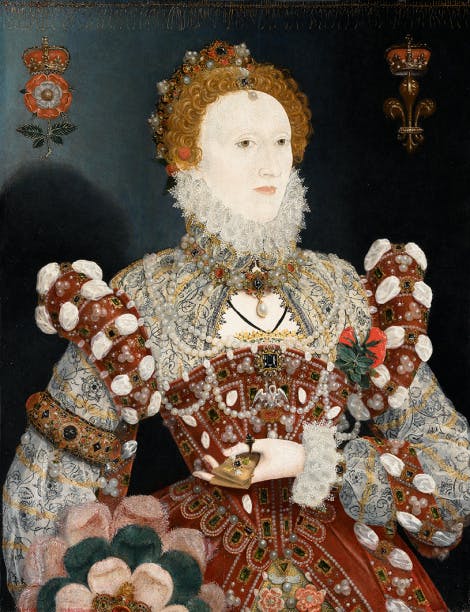
Image: Portrait of Elizabeth I, by Nicholas Hilliard, c1573-5. Presented to the Walker Art Gallery by Alderman E Peter Voues in 1945.
Elizabeth the Virgin Queen
Elizabeth did not marry and did not have any children. But, rather than cause unrest, the Queen’s image of virginity became an unlikely source of unity, a defiant symbol of her virtue and sacrifice.
Portraits of Elizabeth became loaded with symbolism borrowed from the Virgin Mary or the chaste classical goddess Diana, and – like a goddess – Elizabeth’s appearance in art remained ever-youthful. For example, in the portrait of Elizabeth by Nicholas Hilliard c.1573-5, the Queen appears as an icon, bedecked in precious jewels and religious symbolism. The pelican brooch represents Elizabeth’s sacrifice: the mother pelican was believed to feed her own blood to her young.
Loyal supporters wore her image as a badge, courtiers gushed their admiration in poetry, and the wider country celebrated in festivals and pageants; Elizabeth was married to England.

Image: Portrait Miniature of Elizabeth I, by Nicholas Hilliard, c1595-1600. The queen is in her 60s, but Hilliard has hidden Elizabeth’s ageing features behind a ‘mask of youth’. Royal Collection Trust / © Her Majesty Queen Elizabeth II 2019, RCIN 421029
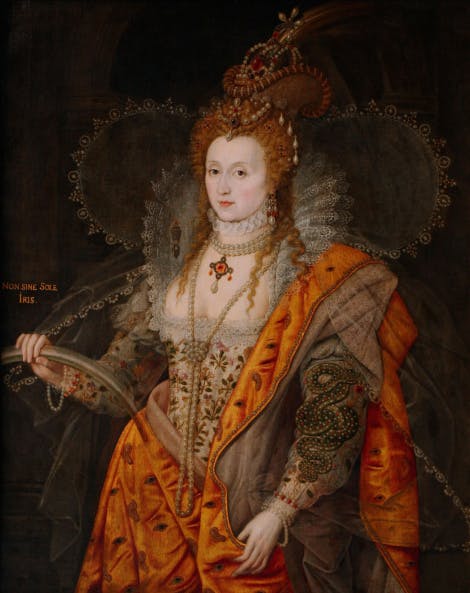
Image: Portrait of Elizabeth I, by Isaac Oliver, the ‘Rainbow Portrait’ of c1600. Reproduced by permission of the Marquess of Salisbury, Hatfield House
Gloriana, the immortal goddess
The fantastical costume and the ageless face in portraits of Elizabeth I create a dazzling impression of the ideal ‘Gloriana’ of Edmund Spenser’s ‘The Faerie Queene’, written between 1589-96.
In the ‘Rainbow Portrait’, The eyes and the ears on the Queen’s dress made clear that she saw everything, while Elizabeth was also the sun, giving life to the rainbow held in her right hand: only the Queen could ensure peace and prosperity.
Against the odds, Elizabeth’s personal bravery and charisma, mixed with a natural inclination to compromise rather than dictate, helped stabilise the country.
Watch The Lost Dress of Elizabeth I
For years, an incredibly rare Tudor treasure lay tucked away in a church in the rural hamlet of Bacton.
Now, new research has uncovered that this is in fact part of a dress worn by someone of the highest nobility at the Elizabethan court. Evidence points directly to the wardrobe of Elizabeth I, making it the only known surviving example of Elizabeth's clothing.
This content is hosted on YouTube
This content may be using cookies and other technologies for which we need your consent before loading. To view the content, you need to enable cookies for "Targeting Cookies & Other Technologies".
Manage CookiesVideo Transcript of The Lost Dress of Elizabeth I
Follow along with an interactive transcript of The Lost Dress of Elizabeth I on YouTube. A link to open the transcript can be found in the description.
Elizabeth's final years
The last decade of Elizabeth’s reign was a bit of an anti-climax.
Robert Dudley, Elizabeth’s constant friend, died in 1588. Francis Walsingham died in 1590, and William Cecil in 1598. They were succeeded at court by Cecil’s son, Robert, and the impetuous figures of Walter Raleigh and Robert Devereux, Earl of Essex.
Courtiers battled for influence amidst accusations of bribery and corruption; poorly resourced and planned military campaigns led to defeats in Spain, France and Ireland.
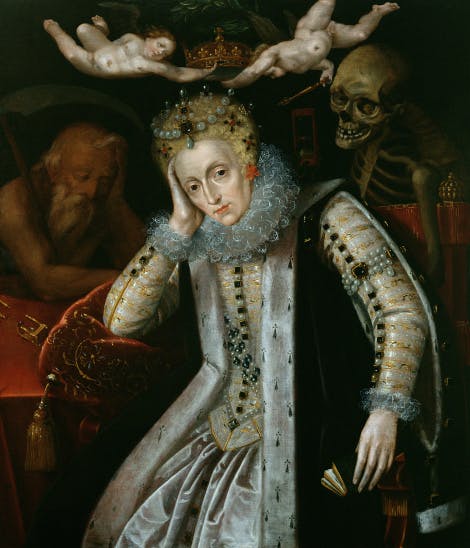
Image: Queen Elizabeth I (1538-1603) in Old Age, c1610, English School. © Bridgeman Images
The death of Elizabeth I
Elizabeth’s ‘Golden Speech’ to Parliament of 1601 may have protested that there was 'no prince that loves his subjects better' but the Arcadian paradise depicted in Elizabethan literature did not reflect the reality of Elizabeth’s England.
High taxes, bad harvests, unemployment, stagnant wages, inflation and crime created discontent, and Elizabeth’s popularity waned.
How did Elizabeth I die?
Elizabeth I died aged 69 at Richmond Palace in the early hours of 24 March 1603. She may have suffered from quinsy, a bacterial infection resulting from tonsillitis, which can be fatal without antibiotics.
During her final days, the Venetian ambassador reported that Elizabeth had a ‘defluxion [abscess] in the throat’; it is this abscess that provides a clue to her final illness.
Who reigned England after Elizabeth I?
With no other obvious successor to Elizabeth I's crown, James VI of Scotland, son of Mary, Queen of Scots, acceded to the English throne as James I. This joined England and Scotland together.
Read more: Arbella Stuart: Elizabeth I’s forgotten heir
Funeral and burial
Despite the problems of her last years, the chronicler John Stow reported at her funeral, 'There was such a general sighing, groaning and weeping as the like hath not been seen or known in the memory of man.'
Elizabeth was buried in Westminster Abbey, initially in the vault of her grandfather Henry VII.
In 1606, James I erected a monument to Elizabeth in Westminster Abbey, and the Queen was reinterred beneath, in a vault shared with her half-sister Mary I.

Image: Locket ring belonging to Queen Elizabeth I, c1575, English School, supposedly removed from the finger of the dead Queen and taken to James VI of Scotland to inform him of Elizabeth's death. © Bridgeman Images
Elizabeth the survivor
Elizabeth I's early life defined her reign.
Her mother’s execution, her father’s tyranny, her brother’s revolutionary Protestantism and her sister’s reactionary Catholicism, taught her, above all else, how to survive.
This meant that Elizabeth the Queen avoided risk, sought compromise and carefully cultivated an image of herself as the protectress of a grateful nation. But was this true?
Read more: The Elizabethan era: a golden age?
Elizabeth I's legacy
One of Elizabeth’s mottoes was 'I see but say nothing'. The Queen avoided controversy when she could. There is no record of her ever mentioning her mother, Anne Boleyn, in public.
Yet when she did speak, Elizabeth was an inspirational monarch, who – for the majority of her 44-year reign – commanded the loyalty of the ambitious men who ran her government.
But Elizabeth was a Tudor. Like her father Henry VIII, she could be arrogant and spiteful, and also maddeningly indecisive. After ordering the execution of Mary, Queen of Scots, her adoption of mourning clothes, and pretence that the decision had not been hers, was an act of self-pitying hypocrisy worthy of her father.
Elizabeth I's importance and impact transcend her own time. Indeed the succession of James VI and I joined England and Scotland together.
Listen to the podcast
Elizabeth I: The women who shaped a Queen
Elizabeth I was profoundly shaped by the women around her. In this series of the Historic Royal Palaces Podcast, Tracy Borman explores these pivotal relationships throughout her life.
Joining Tracy in this episode is Dr Nicola Tallis. We explore the young Elizabeth, before she came to the throne. The formative relationships she experienced during this time shaped the queen she would become; her mother Anne Boleyn, her stepmother Katherine Parr, and her sister Mary I.
More episodesDiscover more about Elizabeth I

Test your knowledge on Elizabeth I
Play the Royal History Quiz online
How much do you know about the Virgin Queen? Put your knowledge to the test with our fun quiz! Whether you are a history enthusiast or curious learner, the Royal History Quiz is your gateway to exploring the past. Take the challenge now and see if you have what it takes to wear the crown!
Browse more history and stories
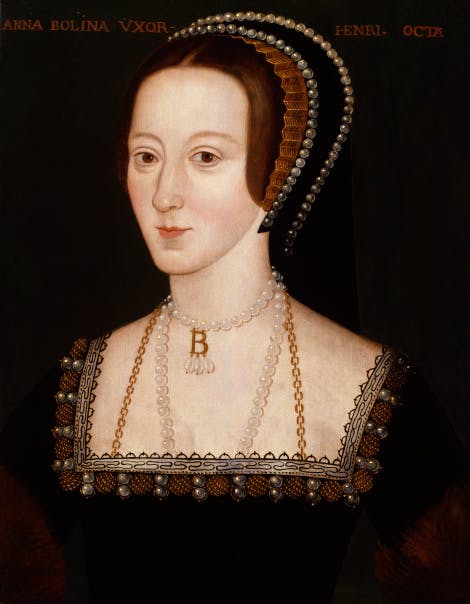
Anne Boleyn
How did Anne Boleyn become queen and why did Henry VIII execute her?
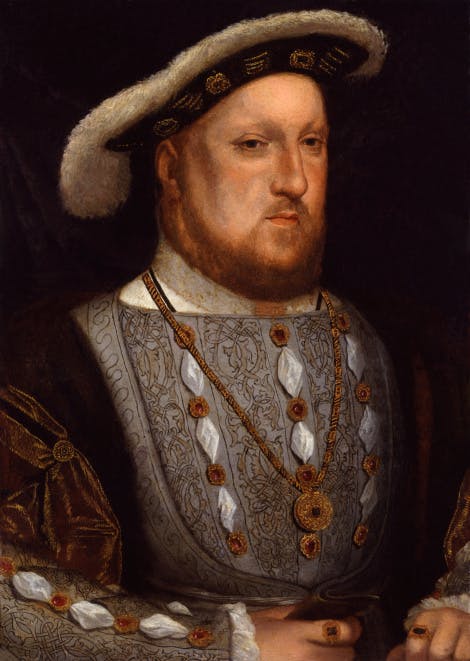
Henry VIII, Terrible Tudor?
Who was the real Henry VIII?

Robert Dudley
Prisoner, favourite and Earl of Leicester
Explore what's on

- Things to see
Great Hall
Experience the splendour of the Tudor court in Henry VIII's Great Hall, complete with his magnificent tapestries.
- Open
- In line with palace opening hours
- Hampton Court Palace
- Included in palace admission (Members go free)

- Things to see
Great Watching Chamber
Discover Henry VIII’s State Apartments and the battle for power at the Tudor court in the Great Watching Chamber.
- Open
- In line with palace opening hours
- Hampton Court Palace
- Included in palace admission (Members go free)

- Things to see
Haunted Gallery and Processional Route
Walk Henry VIII’s route from his private apartments to the Chapel and see the infamous Haunted Gallery in the State Apartments.
- Open
- In line with palace opening hours
- Hampton Court Palace
- Included in palace admission (Members go free)
Shop online

The Stolen Crown by Tracy Borman
The Stolen Crown takes us behind palace doors to reveal the secret history of the Tudor succession.
26.00
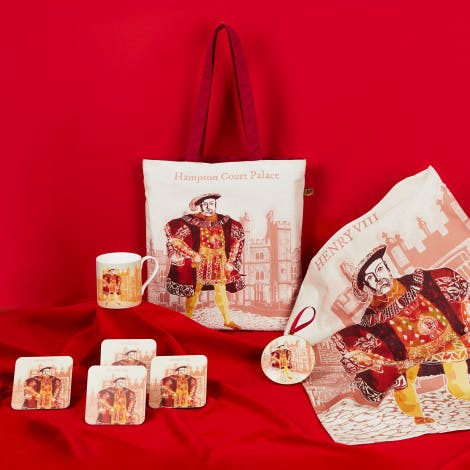
Shop Tudors
Find the perfect gift for collectors and history enthusiasts in our treasure trove of souvenirs inspired by this ever-fascinating dynasty.
From £3.00

Shop Goblets & Tankards
Discover our decadent range of goblets and tankards inspired by the palaces in our care, the perfect gift for any history fan.
From £10.00

